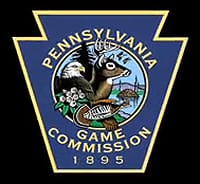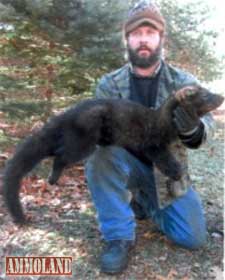Pennsylvania Furtaker Seasons Highlighted By Split Bobcat Season

HARRISBURG, PA –-(Ammoland.com)- A split season for bobcat trappers and hunters highlight this year’s furbearer seasons, according to Pennsylvania Game Commission officials.
In April, the Board of Game Commissioners established a separate bobcat trapping season (Dec. 17-Jan. 8) and hunting season (Jan. 17-Feb. 7). However, both seasons only will be open in Wildlife Management Units 2A, 2C, 2E, 2F, 2G, 3A, 3B, 3C, 3D, 4A, 4D and 4E.
Trappers also will have the opportunity to participate in the second season to harvest a fishers, which will be held Dec. 17-22 in WMUs 2C 2D, 2E and 2F.
Resident and nonresident furtaker license-holders, as well as junior and senior combination license holders, are eligible to participate in both the bobcat and fisher seasons. Bobcat and fisher permits will be available through the agency’s license sale system for $6.70 each. Permits include carcass harvest tags.

Those who harvest a bobcat or fisher must report the harvest to the Game Commission within 48 hours using the online reporting system, which can be accessed through the agency’s website (www.pgc.state.pa.us); telephone reporting system (1-888-724-8681); or by calling the nearest Game Commission region office, a listing of which is posted on page 5 of the 2011-12 Digest.
Last year, the Game Commission removed the need to conduct a public drawing for a limited number of bobcat permits in exchange for a shortened season.
“Following careful review of past seasons and, in consideration of hunter and trapper input, beginning with the 2010-11 season, we decided to use season length to regulate bobcat taking in specified WMUs,” said Dr. Matthew Lovallo, Game Commission Game Mammal Section supervisor. “Our data indicate that bobcat populations have increased significantly.
“In order to continue to assess interest, participation, effort and harvest, we believe it prudent to retain a permitting process. However, we believe that we can offer an unlimited number of permits to allow each furtaker and combination license holder the opportunity to harvest one bobcat in the specified WMUs.”
The creation of a limited, one-week fisher season, which was part of the Game Commission’s initial plans when it reintroduced fishers back in the 1990s, is consistent with the agency’s longstanding goal of promoting and providing hunting and trapping opportunities.
“Through this limited season, we will gather additional biological samples for demographic and genetic analyses,” Lovallo said. “Mandatory reporting, along with fisher permits, is needed to better assess participation, effort and harvest for this new season.”
The cable restraint season for foxes and coyotes opens on Dec. 26, and runs until Feb. 19. Licensed trappers may use cable restraints upon completion of either a four-hour cable restraint certification course or Successful Furtaking Course, both of which are provided by agency-certified volunteer instructors.
The general trapping season – for coyotes, foxes, raccoons, opossums, skunks and weasels – will open Oct. 23 and runs through Feb. 19. The season for mink and muskrats is Nov. 19 to Jan. 8; beavers, Dec. 26 to March 31.
Raccoon hunting season will begin Oct. 22 and closes Feb. 18, and the season for skunks, opossums and weasels runs from July 1 to June 30, except for Sundays. Red and gray foxes hunting season will open Oct. 22 and runs through Feb. 18, including Sundays. Coyotes also have a year-round season (July 1-June 30) and can be hunted on Sundays.
This past year, the Board of Game Commissioners approved a regulatory change to require trappers to “dog-proof” cubby sets that contain body-gripping traps. Trappers using baited cubby sets within a watercourse should consult the digest to make sure their sets conform to these new regulations. The Board also created regulations to allow for the use of encapsulated trap designs that are very selective for harvesting raccoons.
The 2010 Game-Take and Furtaker Surveys estimated that furtakers took 125,423 raccoons (112,550 in 2009); 58,296 muskrats (63,998); 54,661 red foxes (37,418); 36,188 opossums (37,270); 26,658 coyotes (30,386); 15,691 gray foxes (13,793); 8,935 skunks (8,314); and 8,204 mink (7,261).
Furtakers can expect to see abundant raccoon, red fox, coyote and mink populations afield. Increased muskrat pelt prices resulted in greater muskrat trapper effort over the past few years. The decreasing muskrat harvest trend should begin to stabilize this season. High water levels may have helped muskrats access better habitat in ditches, small streams and ponds in agricultural areas. The gray fox harvest is expected to stabilize or increase this trapping season.
Beaver trappers do not have to have harvested beavers tagged by Game Commission personnel. There are, however, beaver bag limits for each WMU: 40 per season in WMUs 1A, 1B, 3A and 3C; 20 per season in WMUs 2A, 2B, 2D, 2E 2F, 3B, 3D; and five per season in all other WMUs.
Beaver populations increased in many areas partially because of difficult trapping conditions last year. The estimated beaver harvest was 9,254 last year, compared to 9,704 in 2009. An increase in the harvest is expected this season.
Trapping is a highly regulated activity in Pennsylvania. A furtaker license – or combination license – is required to trap in the Commonwealth. All traps must have an identification tag that provides the trapper’s name and address or a number issued by the agency. Body-gripping traps must be set within a watercourse. It is unlawful to set a trap with bait visible from the air, or to disturb the traps of another. Traps cannot have a jaw-spread exceeding 6.5 inches. Traps must be visited at least once every 36 hours and each animal removed.
